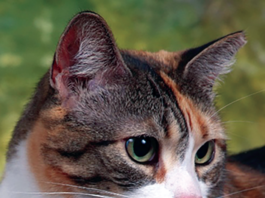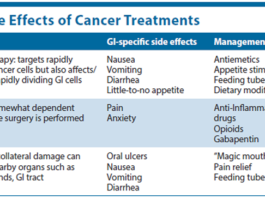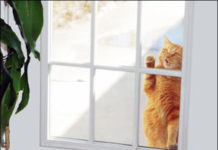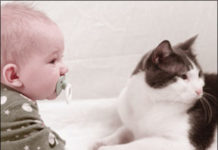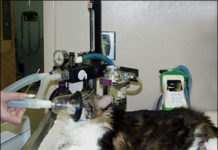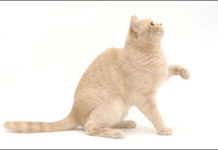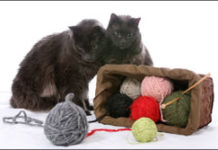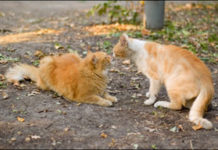Making a Move With Your Pets
Moving day can be a miserable, hectic blur - one of those times youd like to be able to just twitch your nose and be done with it. Unfortunately, it just isnt that easy. And cat owners have the added stress of worrying about how their cat(s) will react to the disorder and mayhem. However, there are several precautions that can be taken to help ensure that your pet will remain safe during the move and to promote a quick adjustment to his new home.
Automatic Devices For Your Cat
Susan McDaniels was having a problem getting her cat, Starfish, to drink enough water. Starfish ignored the bowls of fresh water that were strategically placed around the house, preferring instead to drink water from a drippy faucet. Thats when McDaniels had an idea. What if she could provide fresh, running water for Starfish all the time? "I thought it would be a novel idea to get an automatic waterer for my cat," the Santa Barbara, California, resident remembers. "Nothing else was working." McDaniels went online and purchased an electric waterer that doubled as an attractive fountain. Most importantly, her cat was drinking more water. "Starfish now loves drinking water and finds the fountain very entertaining," she enthuses.
Feline Upper Respiratory Infections
Your seven-year-old cat is a generally healthy animal. Except for a fleeting bout of gastrointestinal upset a few years ago, shes never had a really serious sick-day in her life. But your neighbors cat always seems to be ill. Every couple of months, she shows up on your doorstep wheezing and sneezing. Her eyes are red and watery, and she acts lethargic. These disturbing signs persist for a week or so, but then she seems to be okay again for a while. Its quite likely that the cat next door is suffering from an upper respiratory infection, a highly contagious disease affecting her nose, sinuses, pharynx and larynx the structures that filter, heat and dehumidify inhaled air before it flows to her lungs. Why is it, you wonder, that your cat never experiences this problem, while the cat next door cant shake it?
Do Our Cats Actually Train Us?
Do you ever find yourself playing servant to your cat? Maybe youre working on the computer and your clever cat lies down across the keyboard to get your attention. Next thing you know, youre stroking the cat instead of striking the keys. Perhaps youre watching TV, sleeping or just relaxing and your feline rubs up against your leg, hand or even face to let you know its time to eat. Or your cat may follow you from room to room, pausing to wind around your ankles. Sometimes cats, after getting the attention of their human companions, actually lead them to their food dishes. So what do you do? You feed your cat, of course. The loud purring that follows is music to your ears.
How Smart Is Your Cat?
Humans are very biased in assessing the intelligence of our cats (or dogs). Thats because we tend to judge them according to traits that we can relate to as humans. When cats do something entertaining or "display their independence, we think of them as intelligent," says Julia Albright, MA, DVM, animal behavior resident at Cornell Universitys College of Veterinary Medicine. But there is actually far more evidence for cats intelligence than just our perception of it. According to researchers at Tufts University School of Veterinary Medicine, the physical structure of our brain and that of cats are very similar; they have the same lobes in the cerebral cortex (the "seat" of intelligence) as we do. Our brains function the same way, conveying data via identical neurotransmitters.
Critical Care for Your Cat
A virtually comatose cat was rushed by its distraught owners into the emergency unit of the Cornell University Hospital for Animals (CUHA). The animal, a neutered two-year-old male, hadnt eaten a bite of food or consumed a drop of water for the previous 24 hours. The night prior to his arrival at the hospital, the cat had spent nearly an hour straining in his litter box, apparently in considerable pain, but had neither urinated nor defecated. When his owners awoke the following morning to find the poor animal vomiting intermittently, they finally agreed that emergency care might be warranted. Lucky for them, not to mention the ailing cat, they moved into action. By the time they reached the hospital, the cat was breathing with great effort and lying motionless on his side. A team of veterinarians and licensed veterinary technicians immediately noticed that the animals bladder was grossly swollen. Clearly, it had a blockage in its lower urinary tract that prevented the passage of urine. The team went speedily to work, feeding fluids into the animal intravenously while relieving the obstruction in its urethra.
When Your Cat Wont Eat
When a cats food intake drops off, for whatever reason, the resulting decrease in protein intake can trigger feline hepatic lipidosis (FHL), which is the most common form of liver disease in cats. Inadequate protein mobilizes fat from the adipose tissue, and the fat then accumulates in the liver. "Its a vicious cycle," says Ned Kuehn, DVM, MS, a veterinary internist with Michigan Veterinary Specialists in Southfield, Michigan. "When a cat decreases her food intake, more fat accumulates, making the cat feel worse and eat even less. This makes the hepatic lipidosis get worse." The cat becomes anorexic, and severe liver failure occurs - often in as little as a couple of weeks. "Ive seen it happen within a week," says Dr. Kuehn.Some of the Causes. A wide range of conditions can trigger FHL. "About forty percent of cases are due to environmental changes in the house," explains Dr. Kuehn, who is board-certified by the American College of Veterinary Internal Medicine. Triggers include vacations, moving, a new baby, workers in the home, divorce and even teenagers leaving for college. "Cats become stressed and decrease their food intake," says Dr. Kuehn. Illnesses such as diabetes mellitus, hyperthyroidism or cancer; traumatic injury; or the presence of a foreign body in the intestinal tract may also lead to FHL.
Anesthesia: Whats Involved?
Any surgical procedure that will be painful to your cat - whether its a matter of stitching up a wound, pulling a tooth, repairing a fractured limb or removing a diseased organ - will require that the animals pain perception be dulled, if not totally blocked, by an anesthetic of some sort. What are the chances, an owner might wonder, that the animal, while surviving the operation itself, will fail to fully regain its senses? Or worse: What if it fails to awaken from its drug-induced sleep? "Theres always a risk," acknowledges James Flanders, DVM, an associate professor of surgery at Cornell Universitys College of Veterinary Medicine. "But if the cat is known to be in generally good health and if the anesthetic drugs are used properly, the chance that something will go wrong is very slim." Dr. Flanders assessment is supported by a study published in the Journal of the American Animal Hospital Association that involved tens of thousands of cats. Results showed that for every 1,000 deaths occurring during or subsequent to feline surgery, only one could be directly attributed to anesthesia. This impressive safety record is largely attributable to gains during the past half-century in understanding the medications that are used, and the techniques for monitoring the condition of the animal.
Choosing an Alternative Litter
Over the past decade, numerous products have entered the cat litter market as "alternative" litters. The chief claim of many of these litters is that they are made from plant-based or recycled materials, as opposed to clay, the basis of "traditional" kitty litters. Potential Benefits. As with most products or groups of products, there are both advantages and disadvantages to using alternative cat litters. One advantage that makers of these specialty litters feel appeals to cat owners with environmental concerns is that alternative litters - because they are made of biodegradable substances - present less strain on landfills. Some brands are even marketed as being "compostable" and/or burnable. Additionally, alternative litters are made of materials that often give off little to no dust - which can be a benefit to a cat with upper respiratory issues. "Our general advice to owners of asthmatic cats is to limit environmental exposure to potential irritants of all kinds," says Carolyn McDaniel, VMD, a consultant with the Cornell Feline Health Center. "This includes aerosol cleaning agents, perfumes, cigarette smoke … and dusty cat litter."
How to Help Your Grieving Cat
Ever since one of your beloved cats died several weeks ago, youve been feeling pretty down. People who have been through the same experience tell you this is normal after such a loss. But then you notice that your other cat is eating a lot less, doesnt play like he used to and wanders around the house, yowling, as if he was looking for his lost companion. Do cats grieve like we do? And if so, are there things we can do to help them? Animals and Emotions. Its only within the last ten years or so that scientists have begun to recognize that animals lead rich emotional lives. There is evidence that cats and other animals experience emotional responses to significant changes in their environment - and this includes going through the grieving process after the loss of feline or human companions. "What is important for people to realize is that the same brain neurochemistry that allows humans to feel is the same neurochemistry that many animals have - including cats. Cats can mourn," says Katherine Houpt, VMD, PhD, the James Law Professor of Behavior Medicine at Cornell Universitys College of Veterinary Medicine.
Abscesses: Take Them Seriously
For several days, your cat has been acting uncharacteristically lethargic and off his food. Then one evening, while stroking his back, you feel a smallish lump just to the side of his tail. Although you touch the lump gently, he responds with a hiss, leaping from your lap and scurrying into a dark corner. The lump you discovered is quite possibly an abscess, and the sensitive swelling may indicate that the cat has an infection - and necessitating prompt veterinary care. Distinctive Characteristics. An abscess is a localized collection of pus, a yellowish fluid that forms at the site of an infection. Although pus typically contains a certain amount of cellular debris and dead tissue, it is composed mainly of white blood cells that have been summoned by the immune system to combat invading bacteria or other microorganisms. Cats can develop a variety of lumps and bumps on their skin - cysts, tumors, pimples and so forth - but abscesses have their own distinctive characteristics, notes William Miller, VMD, medical director at Cornell Universitys Companion Animal Hospital. "Because an abscess is filled with pus," he says, "it will be inflamed, warm and tender. Tumors are not usually like that, and pimples are merely superficial eruptions, affecting the outer layer of skin and minuscule by comparison to an abscess." External and Internal. An abscess may develop at the site of a penetrating wound - if a cat steps on a thorn, a wood sliver or a piece of glass, for example. But abscess-producing infections in cats usually result from bites from other cats, since the bacteria that cause infection are normal inhabitants of the feline mouth.
Keep a Feline Health Diary
If your cat kept a diary, it might read something like this: Yesterday, I slept, ate, slept some more, chased a paper ball, napped, ate again and napped. While that may describe a cats typical day, it wont necessarily help you or your veterinarian if your cat develops a health or behavior problem. "Keeping a diary for your cat is a good idea in general, but particularly when your cat is ill," says Drew Weigner, DVM, who is board-certified by the American Board of Veterinary Practitioners. Keep Track of the Basics. At a minimum, you should track your cats veterinary visits, vaccinations, flea treatments and any medications your cat takes. Beyond that, record anything that is unusual for your particular pet. For example, if you change your cats diet, note the date and track changes (such as vomiting or diarrhea). Or, if your cat urinates more or less often than usual, record that in the diary. "If there is anything unusual, or if you start seeing something more often, you should take a trip to the veterinarian," says Dr. Weigner, whose practice is The Cat Doctor in Atlanta, Georgia. If your cat exhibits any changes in behavior, you should note anything unusual thats happened in the house, such as human visitors or changes in the environment. Are strange cats hanging around outside? "Anything can act as a trigger," says Dr. Weigner. "Keeping a journal helps separate the subjective from whats objective. If you keep a log of it, you know for sure."



